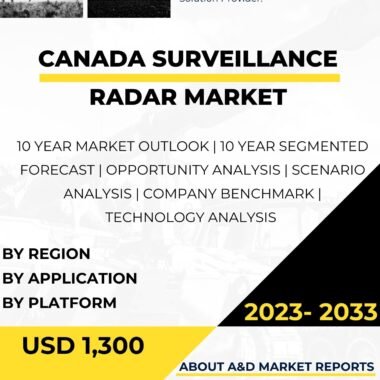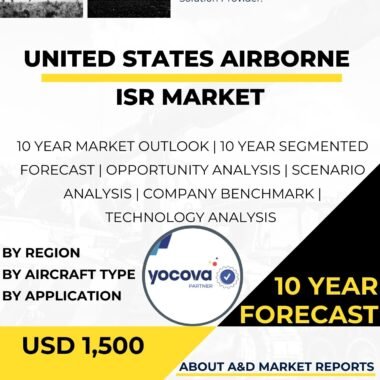Description
The Surveillance Radar market in Malaysia has witnessed significant growth and development in recent years, reflecting the country’s commitment to enhancing its defense capabilities, airspace surveillance, and border security. Surveillance radars are advanced electronic devices used to detect, track, and monitor aerial and maritime activities within a specific region. The adoption of advanced surveillance radar technologies enables Malaysia to establish a robust and modern radar infrastructure, contributing to the country’s overall defense preparedness and national security.
As a nation with strategic geopolitical importance in Southeast Asia, Malaysia faces diverse security challenges, including potential threats from hostile forces, territorial surveillance, transnational crime, and illegal border crossings. The use of surveillance radars enables Malaysia to monitor its airspace, territorial waters, and land borders effectively, detect and respond to potential threats, and safeguard its sovereignty.
The Surveillance Radar market in Malaysia has witnessed significant technological advancements. Modern surveillance radars incorporate advanced signal processing algorithms, high-resolution sensors, and data fusion capabilities, providing enhanced detection ranges, improved accuracy, and real-time intelligence. These advancements have expanded the capabilities and operational effectiveness of surveillance radars, making them indispensable tools for airspace surveillance and border security.
Moreover, surveillance radars play a pivotal role in the capabilities of the Royal Malaysian Air Force (RMAF) and other government agencies. The RMAF utilizes surveillance radars for airspace monitoring, early warning, and air defense operations. Additionally, other government agencies, such as the Malaysian Maritime Enforcement Agency (MMEA), employ surveillance radars for maritime surveillance, illegal fishing detection, and search and rescue missions.
Additionally, the adoption of surveillance radars supports Malaysia’s commitment to enhancing its defense industrial base and fostering indigenous defense capabilities. The Malaysian government has shown interest in developing and manufacturing surveillance radars through local research and development (R&D) initiatives and partnerships with global defense companies.
The Malaysian government has recognized the importance of international collaborations in acquiring and developing surveillance radar technologies. Partnerships with leading global defense contractors and radar manufacturers have facilitated access to cutting-edge surveillance radars and expertise. These collaborations have enabled technology transfer and capacity building, contributing to the growth of Malaysia’s domestic surveillance radar capabilities.
While the Surveillance Radar market in Malaysia shows promise, it is not without challenges. One of the primary hurdles is the high cost of acquiring and maintaining advanced surveillance radars. These sophisticated electronic devices require significant investment in research, development, procurement, training, and logistical support. Budget constraints may impact the pace and scale of surveillance radar acquisition and modernization efforts.
Moreover, ensuring skilled radar operators and specialized training are essential for maximizing the benefits of surveillance radars. The RMAF and other government agencies must invest in continuous training and education to ensure their personnel possess the necessary expertise to operate surveillance radars effectively and interpret the data obtained accurately.
Additionally, addressing radar coverage and integration challenges is crucial for successful surveillance radar operations. Establishing a comprehensive radar coverage network, including long-range, medium-range, and short-range surveillance radars, is essential for ensuring seamless monitoring and response to potential threats.
Looking ahead, the Surveillance Radar market in Malaysia is poised for further growth. The government’s commitment to enhancing its defense capabilities, airspace surveillance, and investing in advanced radar technologies will drive continued investments in radar infrastructure. As surveillance radar technologies continue to evolve and demonstrate their effectiveness, they are likely to play an increasingly pivotal role in Malaysia’s defense and national security strategy.
Moreover, Malaysia’s participation in regional security collaborations and joint radar exercises will likely influence its surveillance radar requirements. As the country seeks to strengthen its position as a key player in regional defense and security cooperation, the demand for advanced surveillance radars with interoperability and compatibility with allied forces will increase.
In conclusion, the Surveillance Radar market in Malaysia has experienced significant growth and progress. The government’s focus on enhancing its defense capabilities, airspace surveillance, and investing in advanced radar technologies has paved the way for the integration of modern radar infrastructure. International collaborations and domestic research efforts have positioned Malaysia as a participant in the global surveillance radar technology landscape.
However, challenges related to budget constraints, technology development, training, radar coverage, and engineering expertise must be addressed proactively to sustain and enhance the growth of the Surveillance Radar market in the years to come. By maintaining a modern and well-integrated radar infrastructure, Malaysia can effectively enhance its defense preparedness, airspace surveillance, and overall national security.




